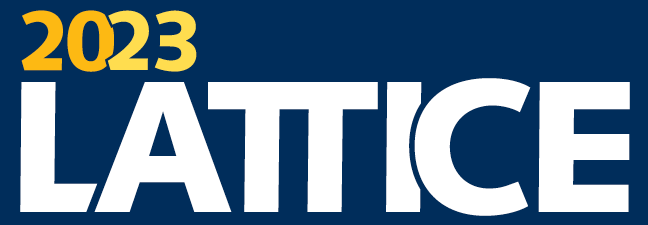Conveners
QCD at Non-zero Density
- Christian Schmidt (Bielefeld University)
QCD at Non-zero Density
- Wolfgang Unger (Bielefeld University)
QCD at Non-zero Density
- Yukari Yamauchi (Institute for Nuclear Theory)
The Hamiltonian formulation of lattice QCD with staggered fermions in the strong coupling limit can be extended to 2 flavors. It has no sign problem at non-zero baryon density and isospin densities and allows for Quantum Monte Carlo simulations. We have implemented a Quantum Monte Carlo algorithm to measure the baryon and isospin densities in the $\mu_B$ - $\mu_I$ plane in the chiral limit. We...
We investigate QCD at large isospin density by computing correlation functions between sources with isospin charge $n=1,\ldots,6144$ on two lattice volumes at quark masses corresponding to a pion mass, $m_\pi\sim170$ MeV. By extracting the energies of the corresponding many-pion systems under the assumption of log-normality of the correlation function distributions, we determine the isospin...
We present a new way of computing the pion screening mass at finite isoscalar chemical potential $\mu_\ell$, starting from the Taylor expansion of the screening correlator in $\mu_\ell$. The method derives from the known exact expression for the free theory pion screening correlator at finite $\mu_\ell$. As a first check of the formalism, we compare the lattice results for the free theory...
We determine the location of the critical point where the first-order deconfining transition in the heavy-quark region turns into a crossover in finite-temperature and density QCD with 2+1 flavors. Combining a hopping parameter expansion of the quark determinant with a reweighting method, we evaluate the chemical potential dependence of the critical point. By systematically calculating the...
The Bielefeld Parma Collaboration has in recent years put forward a method to probe finite density QCD by the detection of Lee Yang singularities. The location of the latter is obtained by multi-point Padè approximants, which are in turn calculated matching Taylor series results obtained from Monte Carlo computations at (a variety of values of) imaginary baryonic chemical potential. The method...
Contour deformation methods have succesfully tamed sign problems in low-dimensional fermionic lattice fields theories at finite density. However, one obstacle with these methods is that they do not guarantee the existence of an integration contour which solves the sign problem completely, thus making it difficult for the methods to be applied to larger and more complex systems, such as lattice...
The sign problem has been an obstacle to first-principles calculations based on the Monte Carlo method. The Worldvolume Hybrid Monte Carlo (WV-HMC) method [Fukuma-Matsumoto 2020] is an efficient method to reduce the sign problem with low cost. In this talk, I apply the WV-HMC to the complex $\phi^4$ theory at finite density, and show that the computational cost is proportional to the degrees...
The sign problem has been a major obstacle to first-principles calculations in various important physical systems. The Worldvolume Hybrid Monte Carlo (WV-HMC) method [Fukuma-Matsumoto 2020] may be a promising method towards solving the sign problem due to its versatility, reliability and low numerical cost. In this talk, I would like to report recent results on the application of the WV-HMC...
In the conventional lattice formulation, conducting a Monte Carlo study of the Schwinger model (quantum electrodynamics in 1 + 1 dimensions) with a topological $\theta$ term or at finite density is almost impossible due to the sign problem. In this talk, I present the lattice formulation of the bosonized Schwinger model, which allows us to study the model using the Monte Carlo method without...
Relativistic fermionic theories with four-Fermi interactions have a broad range of applications, e.g., as toy models for QCD as well as in condensed-matter physics. We study the simplest such theory, the so-called Gross-Neveu model, exposed to a background magnetic field in 2+1 dimensions. In the mean-field limit the model exhibits a rich phase structure when the magnetic field and the...
In low temperature and high density region possible interesting phases are discussed from effective theories which exhibit the same symmetries as QCD, chiral symmetry.
They are pion condensation, color super conducting phases and inhomogeneous chiral condensation.
For spatial dependence of inhomogeneous chiral condensation, various kinds of structures are discussed; chiral density wave,...
The phase diagram at finite density is of great interest. In the literature, calculations are dominated by rooted staggered fermions. In continuum QCD at finite isospin density, there is pion condensation transition. We observe the reminants of such transition at finite lattice spacings as well at nonzero baryon density. In this talk, we discuss how this can be attributed to the ambiguity of...
We present recent results of the Bielefeld-Parma collaboration on the
baryon number density at imaginary chemical potential with
(2+1)-flavors of HISQ fermions on Nt=4,6 and 8 lattices. Based on these
data we calculate Fourier coefficients by means of a Filon-type
quadrature. We discuss how the universal critical behavior is manifest
in the asymptotic behavior of the Fourier coefficients...
Using $N_f=2+1$ QCD calculations at physical quark mass and purely imaginary baryon chemical potential, we locate Lee-Yang edge singularities in the complex chemical potential plane. These singularities have been obtained by the multi-point Padé approach applied to the net baryon number density. We recently used this approach to extract the correct scaling of singularities near the...
Peripheral heavy-ion collisions are expected to exhibit magnetic fields with magnitudes comparable to the QCD scale, as well as non-zero baryon densities. Whereas lattice QCD at finite magnetic field can be simulated directly with standard algorithms, an implementation of real chemical potentials is hindered by the infamous sign problem. Aiming to shed light on the QCD transition and on the...
We obtain the equation of state (EoS) for two-color QCD at low
temperature and high density from the lattice Monte Carlo simulation.
Two-color QCD is a good toy model of a real three-color QCD. The advantage
to study this model is that the sign problem is absent even in a finite
density regime because of the pseudo-reality of the quark field. We find
that the speed of sound exceeds the...
